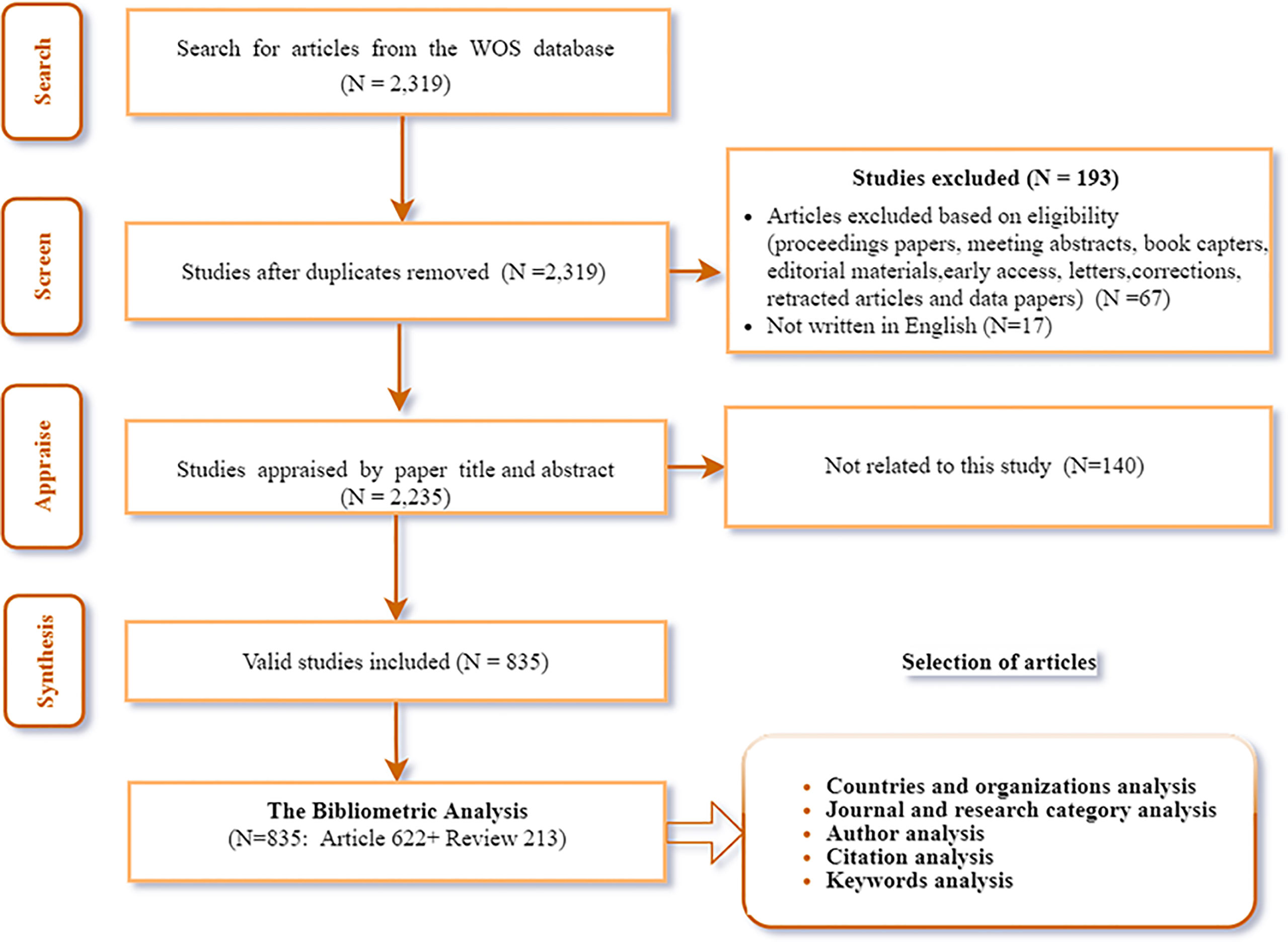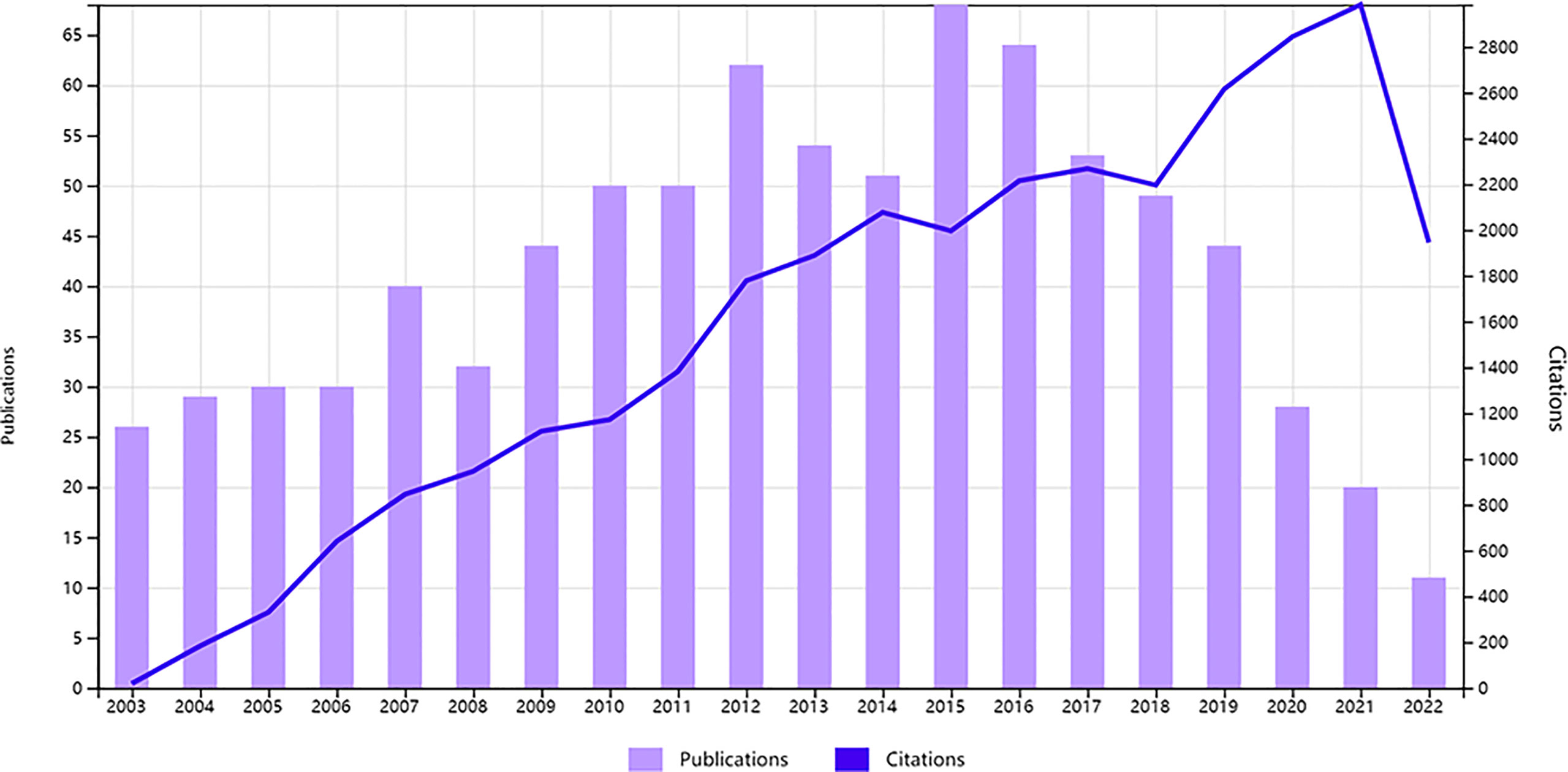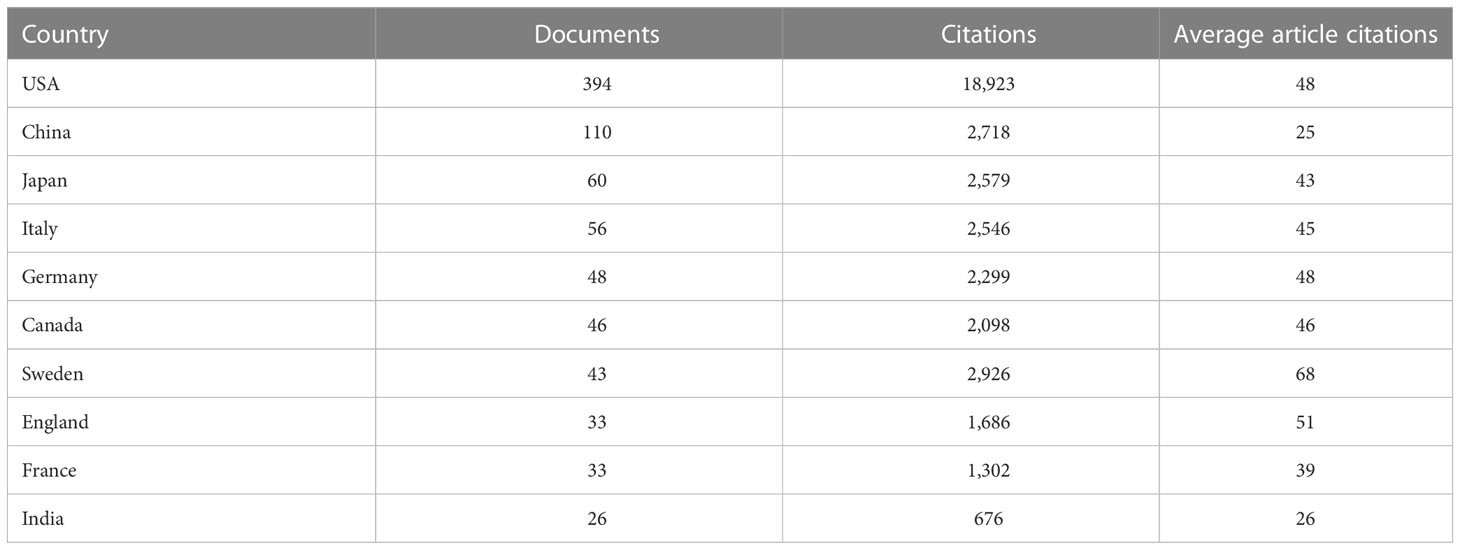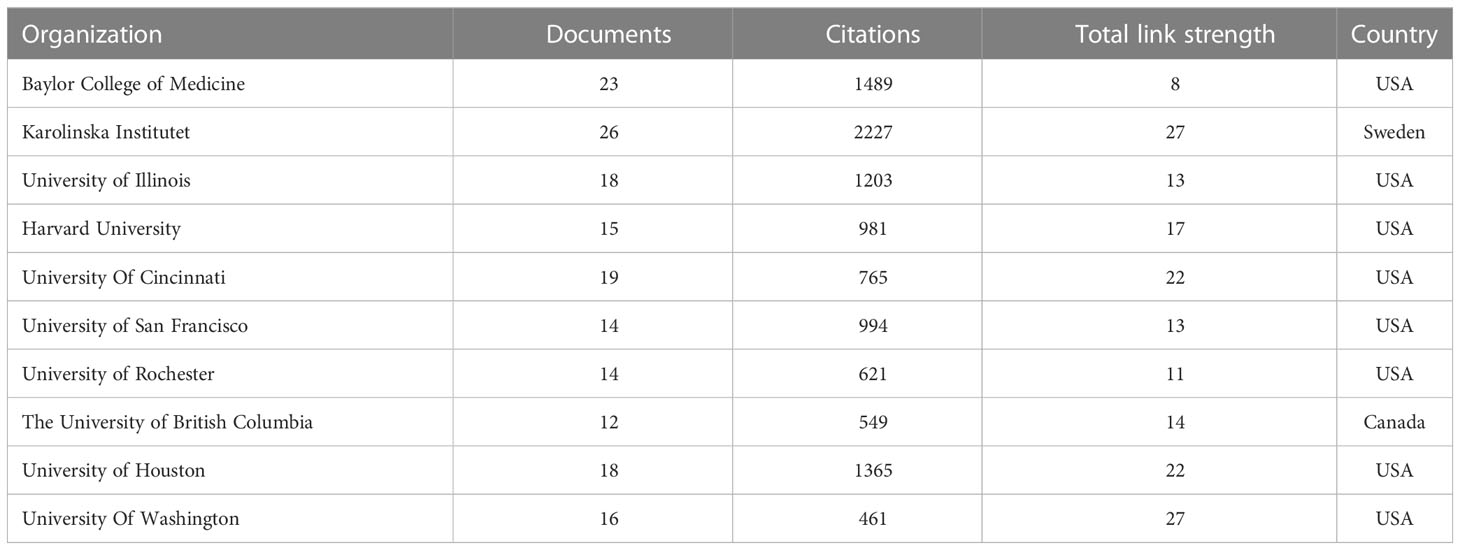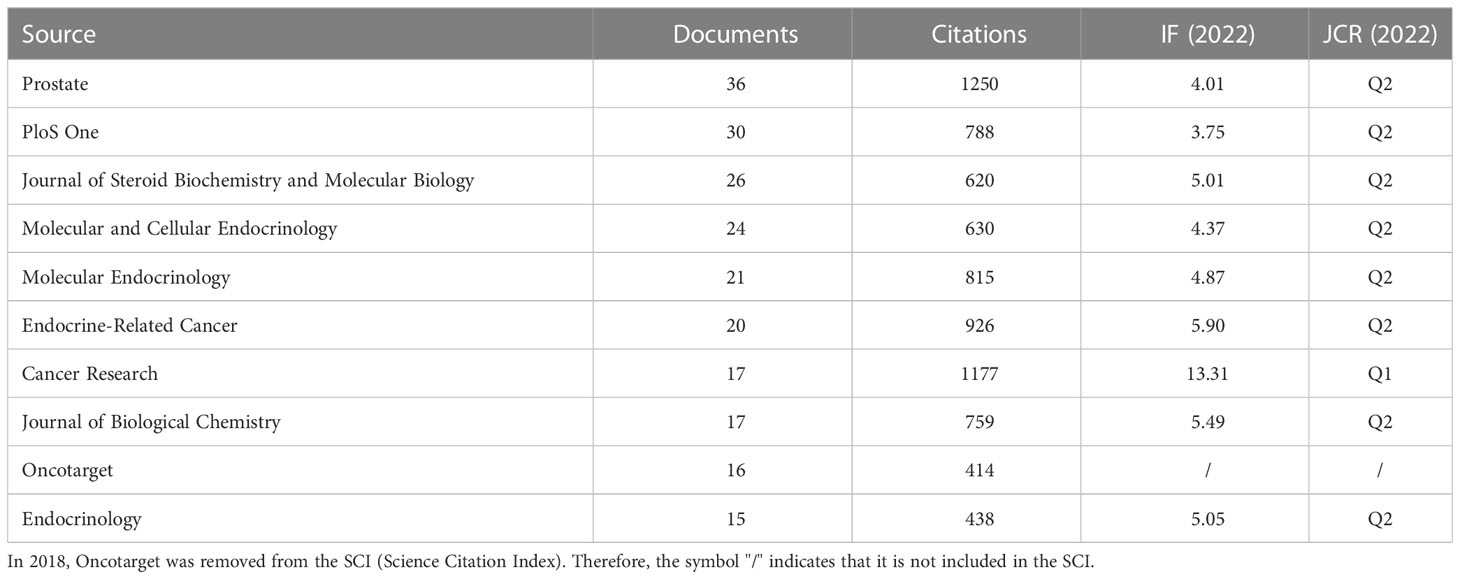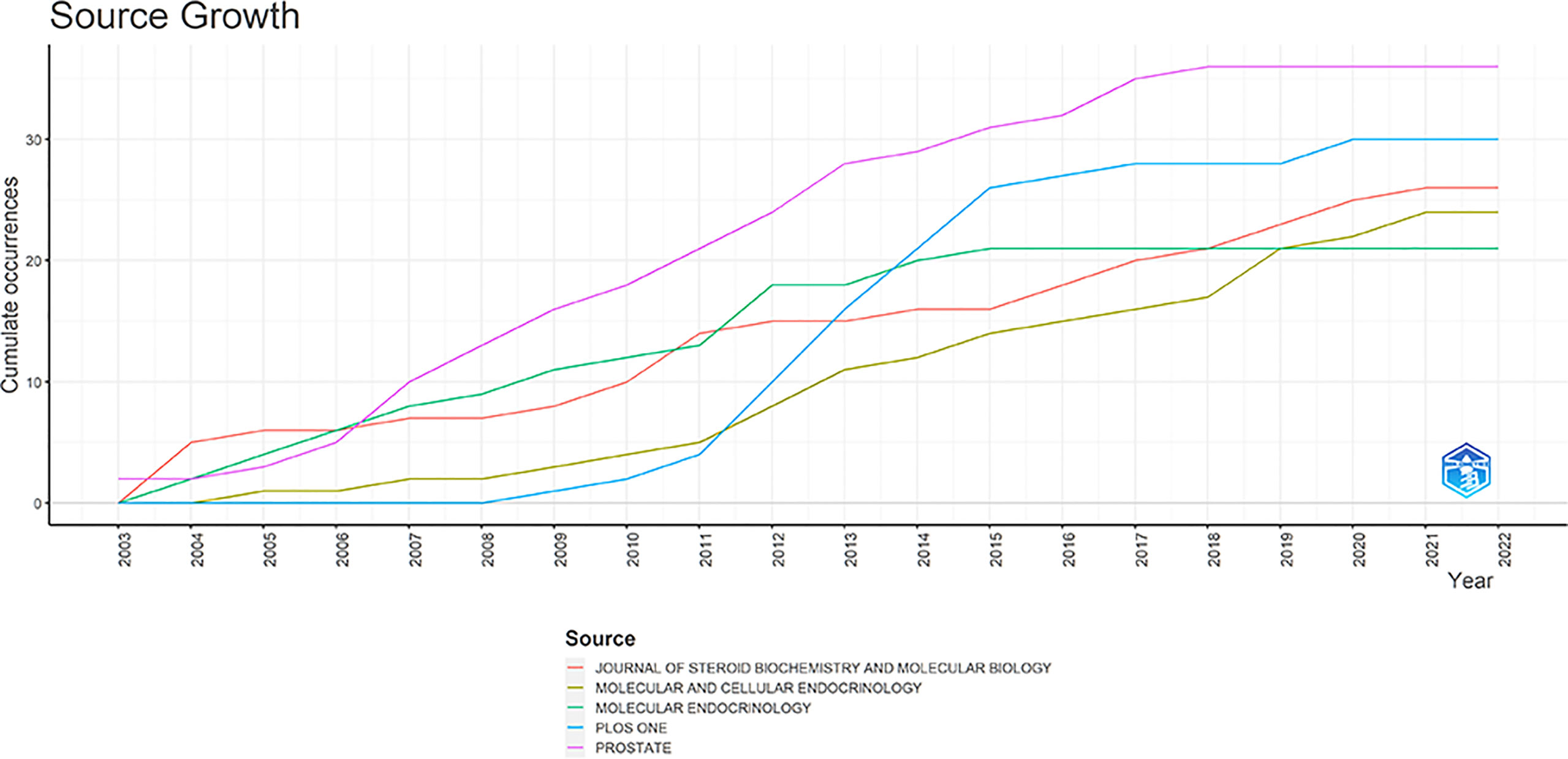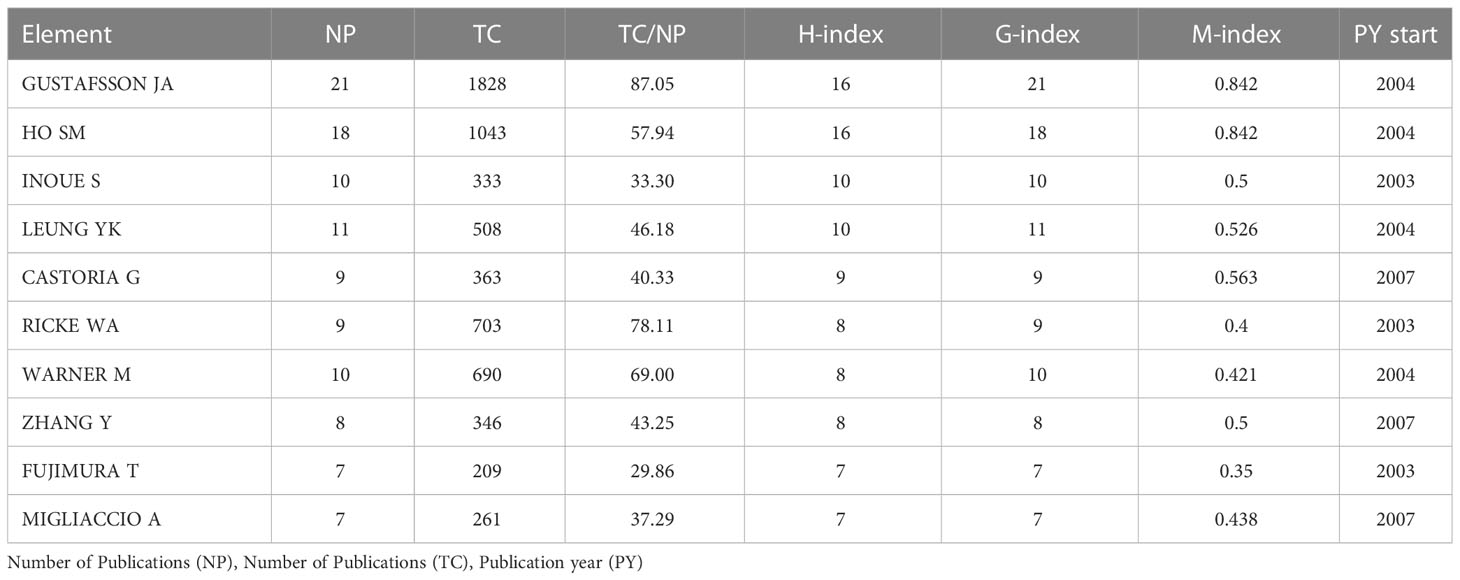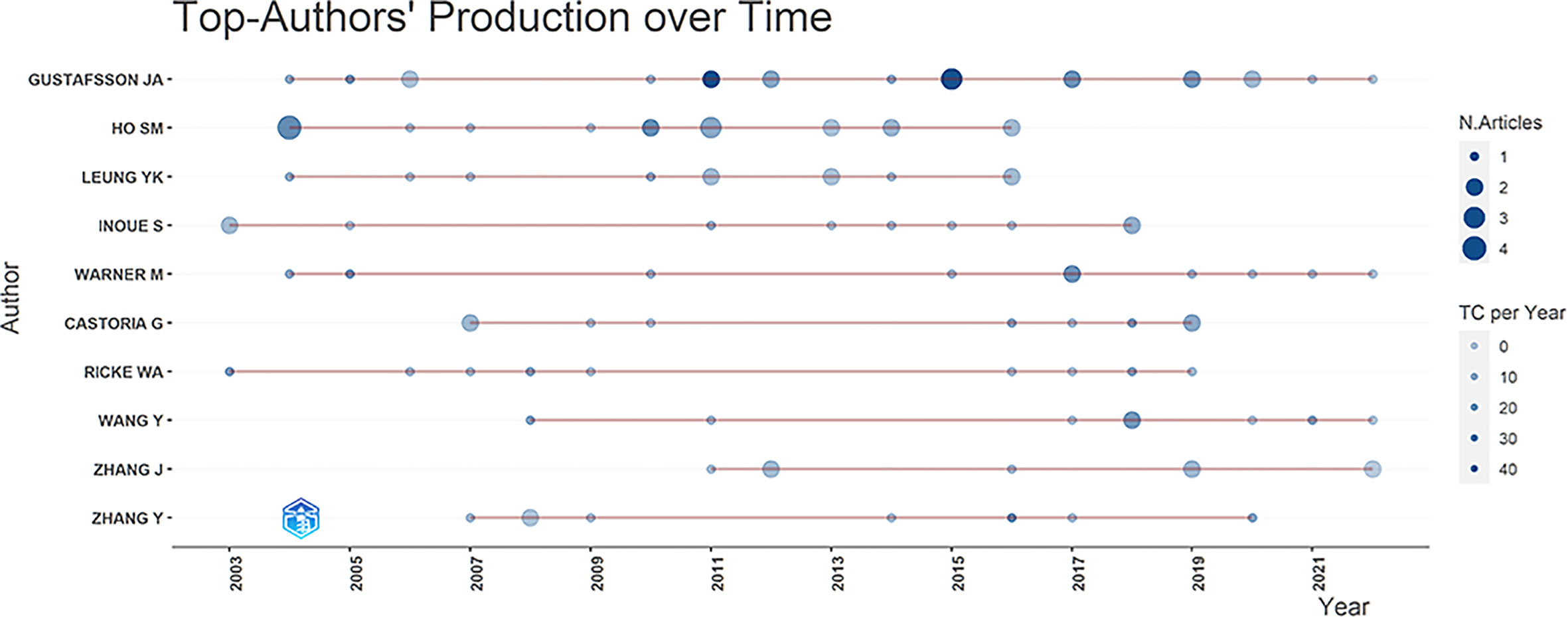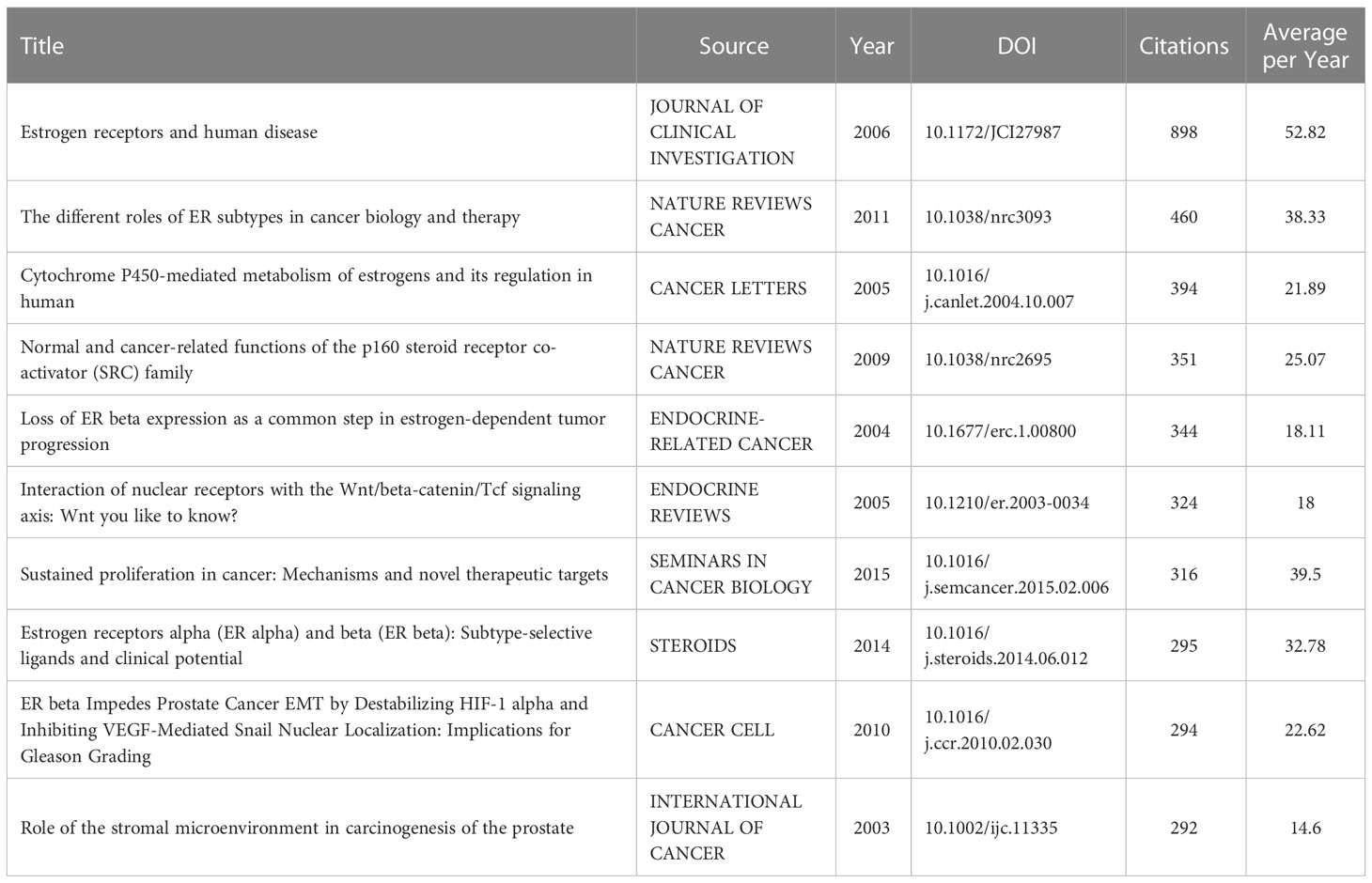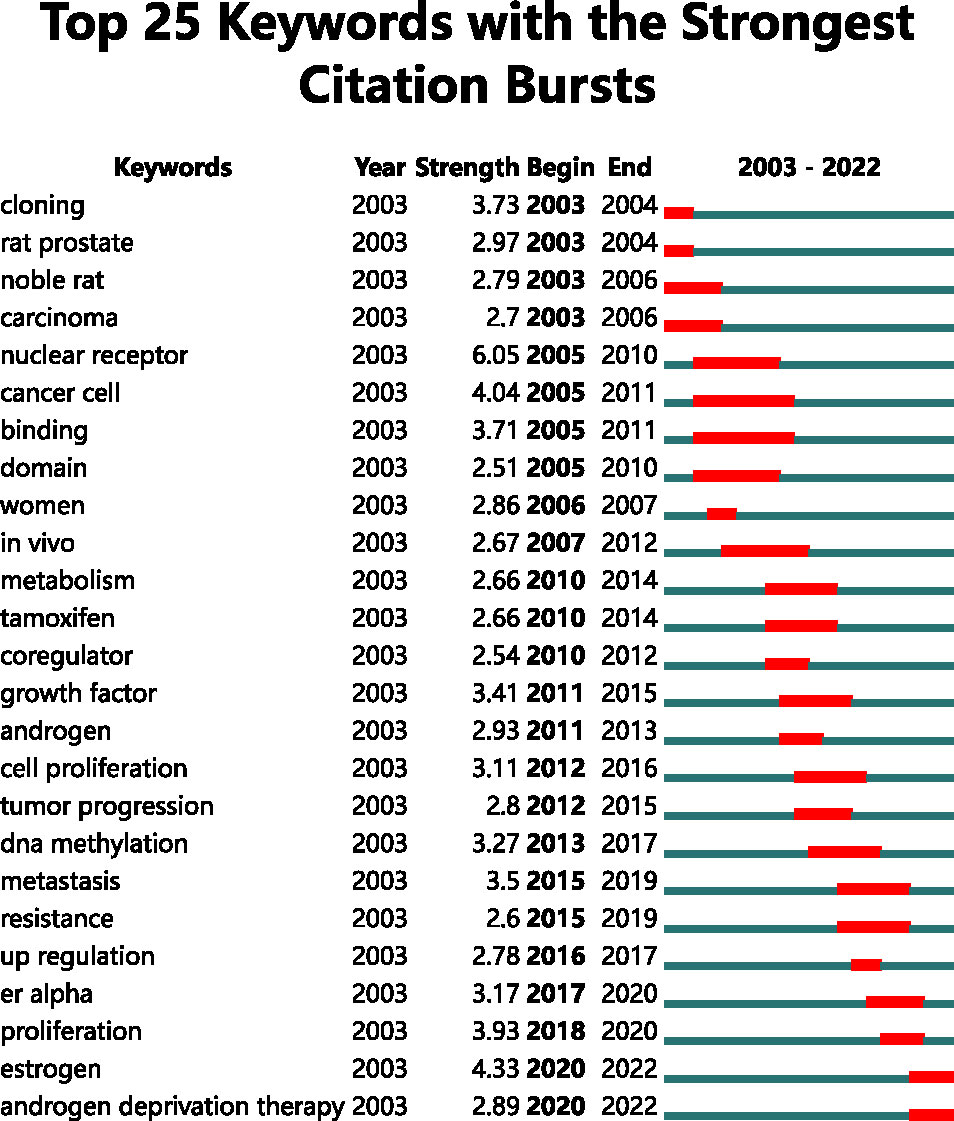- 1Department of Urology, Second Affiliated Hospital of Shantou University Medical College, Shantou, China
- 2Laboratory of Pathogenic Biology, Shantou University Medical College, Shantou, China
- 3Department of Clinical Medicine, Shantou University Medical College, Shantou, China
Introduction: The bibliometric analysis aims to identify research trends in estrogen receptor (ERs) and progesterone receptor (PRs) in prostate cancer (PCa), and also discuss the hotspots and directions of this field.
Methods: 835 publications were sourced from the Web of Science database (WOS) from 2003 to 2022. Citespace, VOSviewer, and Bibliometrix were used for the bibliometric analysis.
Results: The number of published publications increased in early years, but declined in the last 5 years. The United States was the leading country in citations, publications, and top institutions. Prostate and Karolinska Institutet were the most publications of journal and institution, respectively. Jan-Ake Gustafsson was the most influential author based on the number of citations/publications. The most cited paper was “Estrogen receptors and human disease” by Deroo BJ, published in the Journal of Clinical Investigation. The most frequently used keywords were PCa (n = 499), gene-expression (n = 291), androgen receptor (AR) (n = 263), and ER (n = 341), while ERb (n = 219) and ERa (n = 215) further emphasized the importance of ER.
Conclusions: This study provides useful guidance that ERa antagonists, ERb agonists, and the combination of estrogen with androgen deprivation therapy (ADT) will potentially serve as a new treatment strategy for PCa. Another interesting topic is relationships between PCa and the function and mechanism of action of PRs subtypes. The outcome will assist scholars in gaining a comprehensive understanding of the current status and trends in the field, and provide inspiration for future research.
1 Introduction
Prostate cancer (PCa) is a complex problem for middle-aged men in modern society. Based on worldwide cancer data in 2020, there were 1,414,259 new cases and 375,304 deaths worldwide (3.8% of all deaths due to cancer in men), making it the second-most prevalent cancer in men (behind lung cancer), and the fifth leading cause of cancer death (1). In over half of the world’s countries (112 out of 185 countries), PCa is the most commonly diagnosed cancer among men. It is the primary driver of cancer deaths among men in 48 countries, with the highest mortality rates in backward regions, such as the Caribbean, sub-Saharan Africa, and Micronesia (1). The pivotal role of androgen receptor (AR) and its variants have been used as potential predictive and prognostic biomarkers in several stages of PCa (2, 3). The pioneering work of Professor Charles Huggins in 1941 demonstrated androgen deprivation therapy (ADT). ADT is the basic treatment option for locally progressive PCa and castration-resistant prostate cancer (CRPC), and is the basis for a variety of novel combination therapy options, according to the European Association of Urology (EAU) Guidelines on the Treatment of Prostate Cancer. Although more effective AR antagonists have evolved, tumor cell resistance has also evolved, culminating in the almost inevitable progression to fatal CRPC. Recent reports have suggested that ADT may lead to resistance to PCa denervation (4). Therefore, alternative methods are required for ADT to prevent the development of CRPC.
It is known that estrogen receptors (ERs) and progesterone receptors (PRs) play important roles in breast cancer (5). Currently, ERs and PRs targeted therapies are effectively used in breast cancer (6–8), but little information is available in PCa-related targeted therapies. The conventional thinking on synthetic estrogens (mainly hexestrol) is limited by their greater side effects, such as breast feminization, edema, and thrombosis, and also possibly by the lack of reliable and prospective clinical studies. However, numerous researches have suggested that ERs and PRs possibly become novel treatment modalities in PCa. Current results suggest that ERα is generally considered as an oncogene (9), while ERβ usually is a tumor suppressor (10). While relevant research has been completed or is in progress, ERs seem not to have been appropriately taken in clinical treatment. There are still no consistent outcomes on the mechanism of action of PRs. Most studies confirm the oncogenic function of PRs (11, 12), and only a few studies show the tumor-suppressive function (13). It is important to summarize the current research hotspots and trends, but there is no bibliometric analysis of ERs and PRs in PCa.
The study addressed the following questions about ERs and PRs in PCa: 1) What were current trends, and future directions? 2) Which were the most influential authors, sources, institutions, and countries? 3) Which were the most valuable publications? According to the results, not only could quickly find core authors, leading countries, and most influential articles, but also identify the current hotspots and future directions.
2 Materials and methods
2.1 Data analysis
First, we obtained a complete record of all the literature from the Web of Science (WOS), including titles, abstracts, countries, institutions, journals, authors, cited references, and keywords, all of which were downloaded as a txt file and imported into VOSviewer software, Citespace software, and Bibliometrix. The “Citation Report” function was used to obtain all cited articles, the number of self-cited articles, and citations per item.
Bibliometrix was utilized for scientific and visual analysis of data from WOS data. Key information was obtained for all publications, including the number of countries, institutions, sources, authors, documents, and references. We performed a preliminary descriptive analysis of the results, including country collaboration, authors (author production over time, and most relevant authors), sources (source dynamics, and most relevant sources), and most cited documents. VOSviewer is a visualization software for document knowledge units based on visualization of similarities technology, with the unique advantages of easy mapping and beautiful images (14). VOSviewer was used to analyze the most prolific countries, organizations, and sources. As well as the visual analysis of countries, citations and keywords were also generated from VOSviewer. Citespace (version 6.1.R2) is a visualization analysis software that analyzes trends and dynamic changes in the scientific research literature, and can quickly pinpoint key points in the field (15). Papers showing the keywords and references with strong citation bursts were derived from Citespace.
2.2 Data sources
On May 1, 2022, we searched for articles related to ER, PR, and PCa from the WOS core database of Clarivate Analytics, excluding the Arts and Humanities Citation Index (2003-present) version. Medical Subject Headings (Mesh) and the terms “estrogen receptor,” “progesterone receptor,” and “prostate cancer” were utilized as retrieval tactics. The formula for retrieval included the following: TS= (“prostate neoplasm” OR “prostatic neoplasm” OR “prostate cancer” OR “prostatic cancer”) AND TS= (“estrogen receptor” OR “estrogen nuclear receptor” OR “progesterone receptor” OR “progestin receptor”).
There were 2,319 documents generated in this field from January 1, 2003, to May 1, 2022. By excluding non-article or non-review article types and restricting the language to English, 2235 articles were retained. Following that, a manual review was conducted to examine the contents of each article to eliminate irrelevant publications that were not relevant to this study. As follows were the selection criteria: (1) The research topic was unrelated to PCa; (2) The research direction was not ER or PR. Finally, 835 useful articles were retained for the bibliometric analysis (Figure 1).
3 Results
3.1 Publication trends
With the help of Bibliometrix, the 835 papers used in this study were from 4406 authors from 1050 organizations in 51 countries, and published in 323 journals up to May 2022. The published articles were broadly divided into two periods: 2003-2015 and 2016-2021 (Figure 2). In the first period, the number of publications increased yearly and exceeded 50 publications in 2010, indicating that this research area has been receiving more attention. The peak number of relevant publications was recorded in 2015 (n = 68). However, the number of published papers gradually decreased in the second period, possibly indicating that this research field has reached a bottleneck. Prospective research, scientific analysis, and forward direction are urgently needed.
3.2 Analysis of countries and organizations
In the last 20 years, we retrieved 835 papers from WOS with 50 countries contributing to the study field from both developing and developed countries. Table 1 lists the top 10 countries. The United States (USA) had the most publications (n = 394, 47.19% of total), followed by China (n = 110, 13.17%), Japan (n = 60, 7.19%), Italy (n = 56, 6.71%), and Germany (n = 48, 5.75%). The American publications had the most citations (n = 18,923), followed by Sweden (n = 2,926), China (n = 2,718), Japan (n = 2,579), and Italy (n = 2,546). Average article citations over 30 were all from developed countries.
In the co-authorship of countries analysis by VOSviewer (Supplementary Figure S1), the number of countries with over 5 articles was 32. The top 5 countries, ranked by total link strength (TLS), were the USA (TLS = 184), Germany (TLS = 58), Canada (TLS = 57), China (TLS =57), and Sweden (TLS = 54). Total link strength is a way to measure the strength of relationships between nodes. The calculated numbers could reflect strong connections between authors, countries, or other identified elements (16). In other words, the more nodes, the more contributions in the field.
There were 1,050 institutions in this field. Analyzing organizations with over 5 articles, we obtained results for 65 organizations, with Karolinska Institutet contributing the most significant number of publications (n = 26), followed by Baylor College of Medicine (n = 23), University of Cincinnati (n = 19), University of Illinois (n = 18) and University of Houston (n = 18) (Table 2). The top 10 organizations of document volume were all located in the USA, Canada, and Sweden.
3.3 Analysis of journal and research category
All papers were published in 323 journals. The top 10 journals with the highest publications in this field published 222 documents, representing 26.59% of all documents (Table 3). Prostate published the most significant number of documents (n = 36). The second-ranked source was PLoS One (n = 30). Journal of Steroid Biochemistry and Molecular Biology ranked third (n = 26), followed by Molecular and Cellular Endocrinology (n = 24). Prostate was the most cited (1,250 citations), followed by Cancer Research (1,177 citations), and had the highest impact factor (IF = 13.31).
Co-citation analysis of sources was performed in VOSviewer. There were 38 sources with citations over 300, and the max lines were set to 600 to obtain Network Visualization (Supplementary Figure S2A). The element’s size depended on the number of citations (the more citations, the bigger the node), and the different colors represented the different clusters. Density visualization showed that density depended on the number of elements in the surrounding area and the importance of these elements: The higher the density was, the closer it was to yellow (Supplementary Figure S2B). The general clustering trend of sources in the two clusters was that the red group represented the sources in the cancer endocrine field, and the green group represented the sources in the molecular and cellular fields. All clusters almost covered the current topics in our research domains.
The H-index is usually applied to depict the journal’s impact (17). Prostate had the maximum H-index of 21, followed by PLoS One (H-Index = 20), Molecular and Cellular Endocrinology (H-index = 18), Cancer Research (H-Index = 17), and Journal of Biological Chemistry (H-Index = 15) (Supplementary Table S1). Bradford’s law was used to test the quantitative distribution pattern of articles in journals, contributing to searching for core journals (18). According to the source clustering through the Bradford’s Law function of Bibliometrix (Supplementary Table S1), the above journals (Prostate, PLoS One, Molecular Endocrinology, Cancer Research, and Journal of Biological Chemistry) were all in zone 1, which further validated the significance of these journals.
According to the source dynamics function of Bibliometrix (Figure 3), it could be concluded that the field of ERs and PRs related to PCa was on the rise with the year. However, in recent years it has been close to stagnation, indicating an urgent need for novel topics and directions to promote the development in this field. Two journals were worth noting. One was Prostate, has been ranked first in 2006. The other one was PLoS One, which has increased its publication volume year by year since the first article in the field was reported in 2008, having surpassed the second-ranked Molecular Endocrinology in terms of number of articles published in 2013. PLoS One was expected to surpass Prostate to become the first in the field.
A total of 61 research categories were covered by the Analysis Results function of WOS. The top 5 subject categories in terms of number of publications were Oncology (n = 241), Endocrinology Metabolism (n = 194), Biochemistry and Molecular Biology (n = 181), Cell Biology (n = 140), and Urology Nephrology (n =74) (Supplementary Figure S3). Regarding publishers, the most frequent publishers were Elsevier (n = 197 publications), Springer Nature (n = 99), Wiley (n = 99), American Association for Cancer Research (n = 36), and Oxford University Press (n = 33).
3.4 Analysis of authors
Across all datasets, 4,406 authors contributed to the 835 publications, where authors appeared a total of 5477 times, and each document had an average number of authors of 6.56. There were 18 authors of single-authored documents. Among the highly productive authors (Table 4), the top 5 were Jan-Ake Gustafsson (n = 21 articles, 1828 citations), Shuk-Mei Ho (n = 18, 1043 citations), YuetKin Leung (n = 11, 508 citations), Warner, Margaret (n = 10, 690 citations), and Satoshi Inoue (n = 10, 333 citations). Among the most productive authors, four authors had an H-index over 10, namely Jan-Ake Gustafsson and Shuk-Mei Ho were both top 1st place (H-Index = 16), followed by YuetKin Leung and Satoshi Inoue (H-Index = 10). Considering the difference in seniority of researchers, the M-index is a modification of the H-index of time, helping to recognize successful researchers (17). The top two M-Index rankings were Jan-Ake Gustafsson and Shuk-Mei Ho.
The top-the Authors’ Production Over Time (Figure 4) presented the top authors’ publications in the last 20 years. The graph point size was proportional to the overall annual quantity of citations. Since 2018, there has been a general decline in article output, except for Jan-Ake Gustafsson, Margaret Warner, Wang Yue, and Ju Zhang, who have maintained a relatively stable output. Shuk-Mei Ho, and YuetKin Leung published increasingly in the first 10 years but decreasingly in the last 5 years. The outputs of Satoshi Inoue, Gabriella Castoria, William A. Ricke, and Yin Zhang were inconsistent in the previous 10 years.
The three-field plot showed the relationship between the top countries (middle), affiliations (left), and the most productive authors (right) (Supplementary Figure S4). The strength of the connection was represented by the number of the lines. The USA was the most connected country (n = 36), followed by China (n = 22), and Canada (n = 15). The most productive organizations from the USA were the University of California and the University of Pittsburgh (both are 11/36 = 30.56%), followed by Harvard University and the University of Massachusetts (both are 10/36 = 27.78%). The top 2 authors with the strongest trend of collaboration between countries were Brow (n=8) and Risbridger (n = 6).
3.5 Analysis of citations
The number of citations reflects the influence of articles in the field (19). The total citing documents were 23,929 of all retrieved articles, including 23,394 without self-citations (97.76% of all citing documents) and 5,35 self-citations. The number of cited articles was 31,451, which included 28,908 without self-citations. The average number of times cited per document was 37.67. Highly cited papers provided us with frontier research areas. Table 5 provides the top 10 articles based on total citations of ERs, PRs and PCa studies. In 2006, the most cited paper was “Estrogen receptors and human disease” by Deroo BJ, published in the Journal of Clinical Investigation. Among the top 10 articles, 8/10 of the top 10 articles were published in the previous 10 years and still cited today, which meant they had a high reference value. Based on average citations per year, “Sustained proliferation in cancer: Mechanisms and novel therapeutic targets” by Feitelson MA in 2015 (39.5 citations per year) and “Estrogen receptors alpha (ER alpha) and beta (ER beta): Subtype-selective ligands and clinical targets” by Paterni I in 2014 (32.78 citations per year). These two articles have summarized the relatively new field, focusing on clinical potential and novel therapeutic targets.
The top 25 references with the strongest citation bursts were obtained from Citespace (Supplementary Figure S5). Each red or short blue line stood for a year, and the red represented the burst year. In the last 20 years, 36% of references (9/25, 36%) had a citation burst from 2008 to 2012, followed by 2003 to 2007 (8/25, 32%), 2013 to 2017 (7/25, 28%), and 2018 to 2022 (1/25, 4%). The strongest reference to obtain a burst (Strength = 9.82) was a paper by Mak, P et al., with a citation burst occurring between 2011 and 2015 (20). In addition, the review written by Helmut Bonkhoff in 2018 was continuously cited until 2022 (21).
3.6 Analysis of keywords
The co-occurrence analysis of all keywords in VOSviewer had a total of 3,970 keywords and 67 keywords with over 20 occurrences. By manually merging synonyms and removing meaningless keywords (such as breast-cancer and breast etc.), 45 popular keywords were obtained. The most frequently used keywords were prostate cancer (n = 499), gene-expression (n = 291), AR (n = 263), and ER (n = 341), where ERβ (n = 219) and ERα (n = 215) also further determined the importance of ER (Supplementary Table S2). The network visualization indicated that 45 popular keywords were sorted into 5 clusters (Figure 5), which assisted in determining the orientation of the field. Cluster 1, with 16 red items, illustrated the primary microscopic mechanisms (genes, gene expression, phosphorylation, transcription, apoptosis, etc.) and macroscopic manifestations of tumors (growth, metastasis, invasion, progression, proliferation, inhibition, etc.). The green cluster 2, with 13 items, showed an association between the sex hormone (such as estrogen, androgen, and testosterone) carcinogenesis and cancer therapy. The blue cluster 3, with 11 items, described the relationship between receptors (ER, PR, glucocorticoid receptors, and nuclear receptors) and PCa. The density visualization map provided a visual representation of the research priorities in the field (Figure 5B). The keywords “PCa,” “gene expression,” “AR,” “ER,” and “ER-related subtypes” seemed to be hot keywords that were active among the studies in the last 20 years.
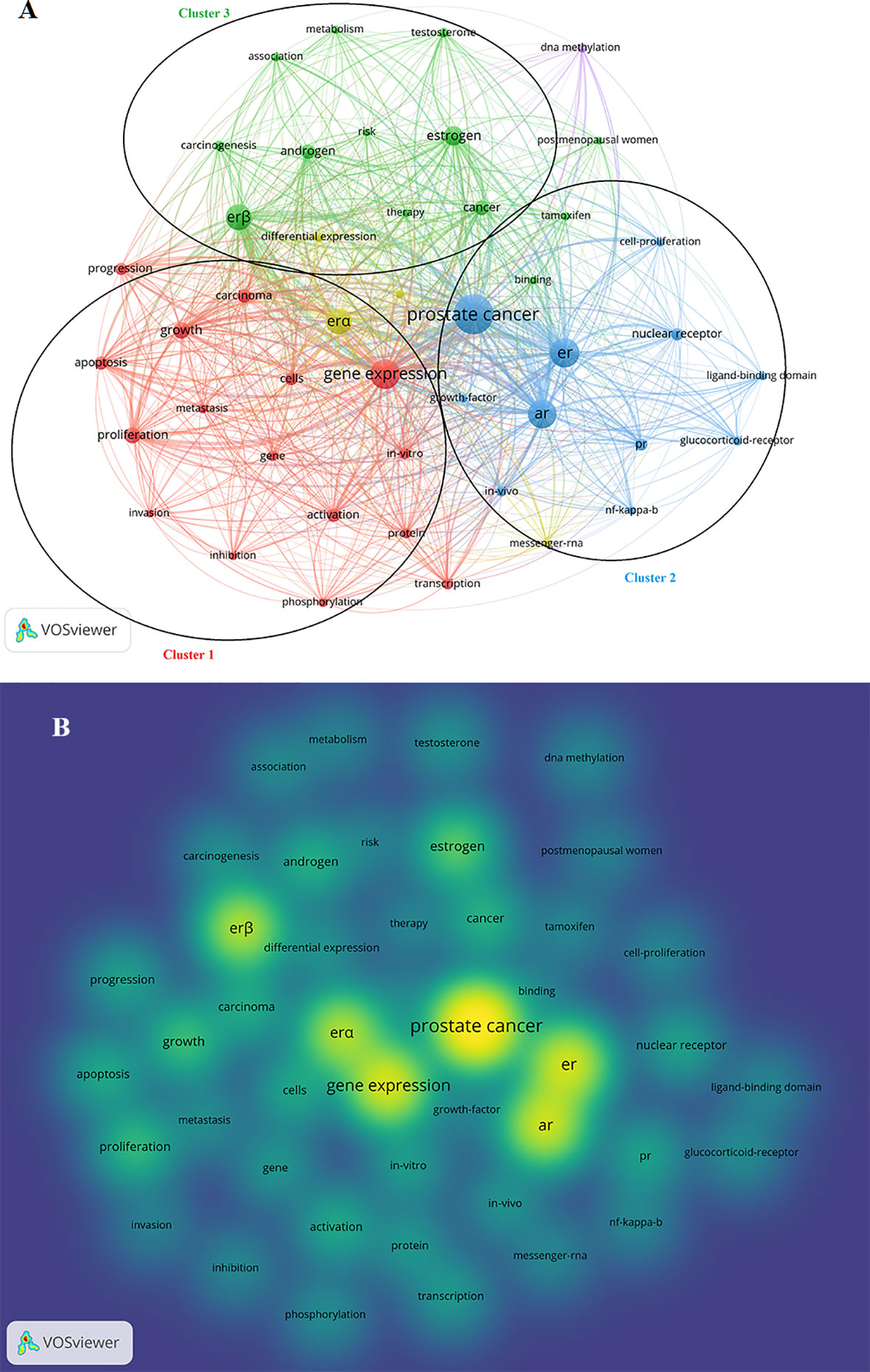
Figure 5 Co-citation analysis of references in the field. (A) Network map of co-citations among references cited over 20 times. (B) Density map of co-citations among references cited over 20 times.
The burst keywords from Citespace provided an access to research trends in recent years and predicted possible future trends (Figure 6). The middle seventeen keywords emphasized the trends of numerous studies from 2005 to 2016, which mainly focused on molecular mechanisms in the middle, such as DNA methylation, up-regulation, and growth factor. The first four keywords showed that the field might be in the animal testing stage. The four recent keywords indicated a lot of attention, meaning they were the focus of current research. The keywords (“estrogen” and “androgen deprivation therapy”) continued to be effective until 2022. The keyword “nuclear receptor” received the strongest burst (strength = 6.05) from 2005 to 2010 citation burst.
4 Discussion
4.1 Global research trends in estrogen receptor and progesterone receptor on prostate cancer
The study conducted a bibliometric analysis of ERs, PRs and PCa with the help of Bibliometrix, VOSviewer, and Citespace. The search strategy and filtering resulted in 835 papers, including 4406 authors, 1050 organizations, 51 countries, 323 journals, and 4,406 authors.
Our research on the relationship between ERs, PRs and PCa started in 2003 with an upward and then downward trend in the number of publications. The peak number of publications in 2015 (n = 67) was 3.4 times higher than the number of publications in 2020 (n = 20). Half of the top 10 highly cited publications were published in the beginning phase (2003-2006), which was probably a time of rapid growth in this research field. All the above findings demonstrated that ER, PR and PCa used to attract a lot of attention from researchers, but in recent years the paper output has declined significantly. It is possible that the research field has hit a bottleneck. For example, whether PCa cell line models express ERβ and the use of different concentrations of estrogen will likely lead to dual activation of ER or regulation of other pathways. These issues remain contentious because of the absence of specific ERβ antibodies (22). It urgently needs forward-looking research, scientific analysis, and providing a way forward.
In total, we introduced 50 countries that have contributed to the development of this field, of which the USA was the pioneer, with the most articles (n = 394) and the most citations (n = 18,923). Eight of the 10 most productive institutions were located in the USA. The countries with average article citations more than 30, and the top 10 publishers were all from developed countries. These results may be attributed to the widespread application of prostate-specific antigen (PSA) testing at the end of the 1980s (23), which led to increased incidence and extensive input of scientific capital. Several developing countries, like India and China, have also made partial achievements in this field. In particular, China has performed well with the second-highest number of publications (n = 110) and the third-highest number of citations (n = 2,926). However, China was relatively weak regarding average citations per item, indicating a lack of high-quality research results. It may be due to China’s relatively late start in this field and lack of experience in international cooperation. Based on GLOBOCAN 2020 data, PCa incidence and death in China account for 8.2% and 13.6% worldwide, respectively. The country shoulders a huge burden of cancer incidence and mortality. Thus, it is proposed that China and its institutions should strengthen cooperation and communication with European and American research institutions to promote progress in this field.
The journals’ analysis showed that researchers focused on the cancer endocrine and molecular fields. Based on the number of articles, the top 5 journals were shown in Table 3: Prostate (n = 36), Journal of Steroid Biochemistry and Molecular Biology (26 articles), Molecular and Cellular Endocrinology (n = 24), Molecular Endocrinology (n = 21), and Endocrine-Related Cancer (n = 20). PLoS One (n = 30) has become the second choice in the field in 2013, partly because it is an open-access journal, which shows that the development of open-access journals in recent years has immensely promoted the advancement of research in this field. Although researchers are still split on the best path to open-access, the concept that research results should be freely shared is broadly accepted (24). The top 5 research categories were Oncology, Endocrinology Metabolism, Biochemistry and Molecular Biology, Cell Biology, and Urology Nephrology. This finding demonstrated the importance of the cancer endocrine and molecular fields again.
The H-index showed that Jan-Ake Gustafsson, Shuk-Mei Ho, Satoshi Inoue, YuetKin Leung, and Gabriella Castoria were the five most accomplished authors in this field. Jan-Ake Gustafsson had the greatest H-index, M-index, publications, and citations, specializing in the role of nuclear receptors in the growth, development, and disease states of various tissues. Jan-Ake Gustafsson booked “The differential role of ER subtypes in cancer biology and therapy” in 2011, the second most cited publication (460 citations), and was widely recognized (25). The author argues that ERβ (especially ERβ1) exerts cancer-suppressive effects, such as oppressing the proliferative effects of ERα, inhibiting epidermal growth factor receptor (EGFR) and suppressing tumor bone metastasis (26–29). Therefore, ERβ1 selective agonist is considered a possible strategy for treating PCa (30).
Jan-Ake Gustafsson remained active in this field and continued contributing to the development of the field (Figure 4). The second H-index was Shuk-Mei Ho, whose research focused on estrogen signaling in PCa. She published her first article on estrogens and PCa in 2004 (165 citations) (31). Subsequently, her research demonstrates the metastasis-promoting role of ERβ2 and ERβ5 in PCa in 2011 (32), and proves that the first discovery of a new non-genomic tumor suppressor “has-miR-765”, which may serve as a novel treatment option for PCa (33).
4.2 Literature review, hotspots, and frontiers
The analysis of citations and keywords enables us to quickly pinpoint the research themes and the core content of publications. It also contributes to our awareness of the field’s current research hotspots and frontiers.
The 10 most cited papers summarized the structure of the existing knowledge framework concerning ER-related subtypes and PCa (25, 34–36). The most cited publication, namely “Estrogen receptors and human disease,” was published by Deroo BJ et al. in the Journal of Clinical Investigation in 2006 (IF = 19.456) and was cited 898 times (34). This article concluded that ERα was oncogenic function only in the prostate stroma; however, ERβ presented in both the luminal epithelial and stroma, and has a cancer-suppressive function. This idea is widely accepted and lays the foundation for subsequent ERs-related studies. Four of the top 10 publications described several signaling pathways and key protein interactions in ER, such as cytochrome P450 (CYP), the steroid receptor co-activator (SRC), and Wnt/β-catenin (20, 37–39). Among them, “Cytochrome P450-mediated metabolism of estrogens and its regulation in human” by Mak P et al. received the strongest citation burst (intensity = 9.82). In an average of more than 30 citations per year, three relatively new articles in this field gradually focused on the shift from mechanisms to clinical treatments (25, 36, 40). However, only minimal work has been done in clinical applications, so further research is needed.
According to the keyword density map (Figure 5B), The keywords “PCa,” “gene expression,” “AR,” “ER,” and “ER-related subtypes” seemed to be hot keywords that were active among the studies in the last 20 years. The keyword cloning hints at the fact that ERα was cloned in the 80s, and ERβ was discovered by the Gustafsson group in 1996 (41). The top 10 keywords of citations were overwhelmingly dominated by ER and its related subtypes. It is reported that there are five subtypes of ERβ. ERβ1 is wild-type, and the others are splice variants designated as ERβ2-5 (42). ERβ1 is the unique full-function receptor, while ERβ2, ERβ4, and ERβ5 counteract ERβ1 (43), with the largest degree of dominant-negative regulation occurring between ERβ1 and ERβ2 (44). Namely, ERβ1 has the predominant tumor-suppressive effect. On the contrary, ERβ2, ERβ4 and ERβ5 splice variants have oncogenic functions (45). Among them, ERβ2 not only has oncogenic function, but also participates in bone metastasis of tumor, which plays an opposite role to the tumor-suppressive function of ERβ1 (46). ERβ is considered as a tumor-suppressive receptor, and favoring its activation would lead to PCa regression. Conversely, ERα stimulates cell proliferation of PCa and its expression is higher as the tumor progresses (9). Thus, ERα antagonists or ERβ agonists emerge as an attractive alternative therapy for CRPC. It can be found that most of the burst words concentrated in 2010-2017 (Figure 6), where mechanisms and signaling pathways (such as coregulator, growth factor, DNA methylation, and up regulation) occupy the leading position and also enter the peak period of publication at the same time. Since 2020, the keywords “estrogen” and “androgen deprivation therapy” were the citation burst. Therefore, the study focus has switched to medical treatment. It is known that ADT is the predominant treatment for PCa, and ADT is initially effective but causes eventual CRPC. An explanation could be that AR is expressed only in epithelial cells of the prostate lumen but not in basal cells. This localization pattern is well explained by the fact that ADT can inhibit AR-positive PCa proliferation but has no effect on basal cell proliferation/differentiation. In addition, dihydrotestosterone (DHT) can be endogenously metabolized to 5α-androstane-3β. ADT blocks DHT production and then decreases endogenous estradiol (5α-androstane-3β), a ligand for both ERs (47). Endogenous estradiol binds to both ERβ and ERα, having a slightly higher affinity for ERβ (48). Consequently, ADT can inhibit AR signaling, and predominantly inhibit the tumor-suppressive function of ERβ. A recent clinical study by Jan-Ake Gustafsson showed that ADT, such as finasteride (5α-reductase inhibitor), enzalutamide (AR blocker), and abiraterone (androgen synthesis inhibitor), promoted EGFR nuclear translocation and increased PCa proliferation on the treatment of PCa. Another result from this study showed that treatment with isoflavones (ERβ agonists) inhibited finasteride-induced EGFR nuclear translocation during prostatic hyperplasia (BPH) treatment (28). Therefore, ERβ receptor agonists with ADT may be used as a new modality to treat PCa since nuclear EGFR predisposes to CRPC. Biochemical recurrence rates in bone metastatic PCa have been reported to be improved by the combination of toremifene (a selective estrogen receptor modulator) and ADT (49), and fulvestrant (a selective estrogen receptor down regulator) is able to reduce PSA levels in some patients without any detectable toxicity (50). It is exciting that the combination of estrogen with ADT will potentially serve as a new treatment strategy for PCa. However, it should be considered that there seems to be possible crosstalk between ERs and the G-coupled protein estrogen receptor (GPER) before estrogen is put into therapy (51). GPER is a membrane estrogen receptor, which is expressed in both PCa and normal glands (52) GPER-mediated responses have a key role in PCa, and ligand binding to GPER activates EGFR involving in the stimulation of tumor migration and invasion (53).
However, PR-related topics did not appear in the top 10 citation papers, and the keyword “PR” only appeared 49 times, suggesting that the field may not have received enough attention, or the mechanism is too complex to be known. In all stages of PCa, the presence of PRs is always linked to the high expression of ERα (54), especially in CRPC, where different levels of PRB transcripts are obtained (55). Most reports show that PRA is only present in the stroma, and PRB is expressed in both the stroma and epithelium. High PRB expression in tumor tissue is correlated with an unfavorable prognosis (11). However, Yu et al. report conflicting results, showing PRs could inhibit tumor proliferation (56), as well as that PRB is not expressed in epithelial cells (13). The difference is possibly due to the heterogeneous structure of the tumor (57). So far, Isikbay et al. have demonstrated the inhibitory effect of mifepristone on CRPC (58). However, this expected effect is not observed in small phase II clinical trials (59). PRs expression may not be directly responsible for tumor proliferation, but rather is the result of other underlying processes. In contrast to ERs, PRs-related studies are likely to be only the tip of the iceberg of complex steroid hormone interactions in PCa development, and the role of PRs in the epithelium and stroma of PCa and the potential individual roles of PRs isoforms remain to be determined.
5 Strengths and limitations
Several advantages are associated with our study. This study first used bibliometric analysis to assess the hotspots and frontiers in ERs, PRs and PCa research. A total of 835 publications on ERs, PRs and PCa research were obtained from WOS. Our study analyzed annual publications, countries, institutions, journals, authors, citations, and keywords. We also merged synonyms and removed irrelevant words for some keywords so that research hotspots and frontiers would be more prominent.
The limitations of this study come mainly from the following aspects. The first is the source data’s limitation which is the inability to directly merge the results from multiple databases, which may omit some important studies. The databases focus more on English language journals, resulting in a lack representation of non-English language journals. Only partial information about the literature is available, and complete information about the articles is not available. Nevertheless, WOS is one of the industry’s best digital literature resource databases and is often used by researchers for bibliometric analysis (60). The complete information of the target article can be obtained by a manual search. The second limitation is the deficiency of research tools. For example, VOSviewer can only generate a map and cannot view the node information, which can only be solved by manually searching to obtain the relevant information. Finally, most of the top 10 articles are reviews and older, probably multidisciplinary, resulting in less specificity in the research field, which requires several researchers to spend much time on scientific analysis of the literature and a more in-depth and comprehensive understanding of the field, inevitably with some subjectivity. We are confident that this bibliometric research could offer a few inspirations and viable ideas for researchers in related fields.
6 Conclusion
It has been widely accepted that AR has a role in PCa. Numerous researchers have recently explored the mechanisms and therapeutic benefits of ER and PR in PCa. This bibliometric study analyzed current trends, major countries, institutions, and core journals in the field, providing research findings from landmark articles, research directions, and hotspots. Relevant research in this field was deepening, from the establishment of the relationship between ER, PR and PCa, to the refinement of microscopic molecular mechanisms, and the transition to clinical treatment. This study provided some directions for researchers. ERα antagonists, ERβ agonists, and the combination of estrogen with ADT would potentially serve as a new treatment strategy for PCa. Another interesting topic is relationships between PCa and the function and mechanism of action of PRs subtypes. The outcome will assist scholars in gaining a comprehensive understanding of the current status and trends in the field, and provide inspiration for future research.
Data availability statement
The original contributions presented in the study are included in the article/Supplementary Material. Further inquiries can be directed to the corresponding author.
Author contributions
QY and XS provided the conception and design of the study. All authors participated in the development of the scheme. GH provided guidance on the use and analysis of these analytical procedures. WL obtained the dataset from Web of Science, performed the statistical analysis, and was a major contributor to writing the manuscript. MY, YL, and JL participated in the interpretation of the study results. XS revised the article critically. All authors contributed to the article and approved the submitted version.
Funding
This work was supported by The Shantou Medical Science and Technology Planning Project (2022-81-22).
Acknowledgment
The authors thank those individuals who provided software usage guidance, language help, writing assistance, and proofreading of the article.
Conflict of interest
The authors declare that the research was conducted in the absence of any commercial or financial relationships that could be construed as a potential conflict of interest.
Publisher’s note
All claims expressed in this article are solely those of the authors and do not necessarily represent those of their affiliated organizations, or those of the publisher, the editors and the reviewers. Any product that may be evaluated in this article, or claim that may be made by its manufacturer, is not guaranteed or endorsed by the publisher.
Supplementary material
The Supplementary Material for this article can be found online at: https://www.frontiersin.org/articles/10.3389/fonc.2023.1111296/full#supplementary-material
Glossary
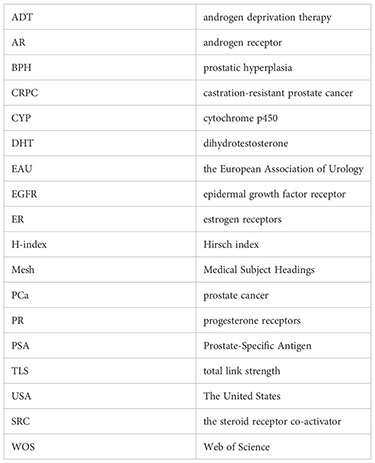
References
1. Sung H, Ferlay J, Siegel RL, Laversanne M, Soerjomataram I, Jemal A, et al. Global cancer statistics 2020: GLOBOCAN estimates of incidence and mortality worldwide for 36 cancers in 185 countries. CA Cancer J Clin (2021) 71:209–49. doi: 10.3322/caac.21660
2. Culig Z, Santer FR. Androgen receptor signaling in prostate cancer. Cancer Metastasis Rev (2014) 33:413–27. doi: 10.1007/s10555-013-9474-0
3. Sciarra A, Maggi M, Salciccia S, Nicolai A, Tortorella E, Giantulli S, et al. Tissue expression of androgen receptor splice variant 7 at radical prostatectomy predicts risk of progression in untreated nonmetastatic prostate cancer. Oncology (2021) 99:251–5. doi: 10.1159/000512445
4. Shaw GL, Whitaker H, Corcoran M, Dunning MJ, Luxton H, Kay J, et al. The early effects of rapid androgen deprivation on human prostate cancer. Eur Urol (2016) 70:214–8. doi: 10.1016/j.eururo.2015.10.042
5. Abe O, Abe R, Enomoto K, Kikuchi K, Koyama H, Masuda H, et al. Effects of chemotherapy and hormonal therapy for early breast cancer on recurrence and 15-year survival: an overview of the randomised trials. Lancet (2005) 365:1687–717. doi: 10.1016/s0140-6736(05)66544-0
6. Cristofanilli M, Turner NC, Bondarenko I, Ro J, Im S-A, Masuda N, et al. Fulvestrant plus palbociclib versus fulvestrant plus placebo for treatment of hormone-receptor-positive, HER2-negative metastatic breast cancer that progressed on previous endocrine therapy (PALOMA-3): final analysis of the multicentre, double-blind, phase 3 randomised controlled trial. Lancet Oncol (2016) 17:425–39. doi: 10.1016/S1470-2045(15)00613-0
7. Finn RS, Martin M, Rugo HS, Jones S, Im S-A, Gelmon K, et al. Palbociclib and letrozole in advanced breast cancer. N Engl J Med (2016) 375:1925–36. doi: 10.1056/NEJMoa1607303
8. Bardou VJ, Arpino G, Elledge RM, Osborne CK, Clark GM. Progesterone receptor status significantly improves outcome prediction over estrogen receptor status alone for adjuvant endocrine therapy in two large breast cancer databases. J Clin Oncol (2003) 21:1973–9. doi: 10.1200/JCO.2003.09.099
9. Takizawa I, Lawrence MG, Balanathan P, Rebello R, Pearson HB, Garg E, et al. Estrogen receptor alpha drives proliferation in PTEN-deficient prostate carcinoma by stimulating survival signaling, MYC expression and altering glucose sensitivity. Oncotarget (2015) 6:604–16. doi: 10.18632/oncotarget.2820
10. McPherson SJ, Hussain S, Balanathan P, Hedwards SL, Niranjan B, Grant M, et al. Estrogen receptor-beta activated apoptosis in benign hyperplasia and cancer of the prostate is androgen independent and TNF alpha mediated. Proc Natl Acad Sci U.S.A. (2010) 107:3123–8. doi: 10.1073/pnas.0905524107
11. Grindstad T, Richardsen E, Andersen S, Skjefstad K, Khanehkenari MR, Donnem T, et al. Progesterone receptors in prostate cancer: progesterone receptor b is the isoform associated with disease progression. Sci Rep (2018) 8:11358. doi: 10.1038/s41598-018-29520-5
12. Hou Z, Huang S, Mei Z, Chen L, Guo J, Gao Y, et al. Inhibiting 3βHSD1 to eliminate the oncogenic effects of progesterone in prostate cancer. Cell Rep Med (2022) 3:100561. doi: 10.1016/j.xcrm.2022.100561
13. Yu Y, Liu L, Xie N, Xue H, Fazli L, Buttyan R, et al. Expression and function of the progesterone receptor in human prostate stroma provide novel insights to cell proliferation control. J Clin Endocrinol Metab (2013) 98:2887–96. doi: 10.1210/jc.2012-4000
14. van Eck NJ, Waltman L. Software survey: VOSviewer, a computer program for bibliometric mapping. Scientometrics (2010) 84:523–38. doi: 10.1007/s11192-009-0146-3
15. Chen C. CiteSpace II: detecting and visualizing emerging trends and transient patterns in scientific literature. J Am Soc Inf Sci Technol (2006) 57:359–77. doi: 10.1002/asi.20317
16. MacDonald KI, Dressler V. Using citation analysis to identify research fronts: a case study with the Internet of things. Sci Technol Libr (2018) 37:171–86. doi: 10.1080/0194262X.2017.1415183
17. von Bohlen und Halbach O. How to judge a book by its cover? how useful are bibliometric indices for the evaluation of “scientific quality” or “scientific productivity”? Ann Anat - Anat Anz (2011) 193:191–6. doi: 10.1016/j.aanat.2011.03.011
19. Sevinc A. Web of science: a unique method of cited reference searching. J Natl Med Assoc (2004) 96:980–3.
20. Mak P, Leav I, Pursell B, Bae D, Yang X, Taglienti CA, et al. ER beta impedes prostate cancer EMT by destabilizing HIF-1 alpha and inhibiting VEGF-mediated snail nuclear localization: implications for Gleason grading. Cancer Cell (2010) 17:319–32. doi: 10.1016/j.ccr.2010.02.030
21. Bonkhoff H. Estrogen receptor signaling in prostate cancer: implications for carcinogenesis and tumor progression. Prostate (2018) 78:2–10. doi: 10.1002/pros.23446
22. Lafront C, Germain L, Weidmann C, Audet-Walsh É. A systematic study of the impact of estrogens and selective estrogen receptor modulators on prostate cancer cell proliferation. Sci Rep (2020) 10:1–12. doi: 10.1038/s41598-020-60844-3
23. Center MM, Jemal A, Lortet-Tieulent J, Ward E, Ferlay J, Brawley O, et al. International variation in prostate cancer incidence and mortality rates. Eur Urol (2012) 61:1079–92. doi: 10.1016/j.eururo.2012.02.054
24. Huang C-K, Neylon C, Hosking R, Montgomery L, Wilson K, Ozaygen A, et al. Meta-research: evaluating the impact of open access policies on research institutions. Cambridge, England: eLIFE Sciences Publ LTDSHERATON House (2020). doi: 10.7554/elife.57067.sa1.
25. Thomas C, Gustafsson J-A. The different roles of ER subtypes in cancer biology and therapy. Nat Rev Cancer (2011) 11:597–608. doi: 10.1038/nrc3093
26. Jorissen R. Epidermal growth factor receptor: mechanisms of activation and signalling. Exp Cell Res (2003) 284:31–53. doi: 10.1016/s0014-4827(02)00098-8
27. Chaurasiya S, Widmann S, Botero C, Lin C-Y, Gustafsson J-A, Strom AM. Estrogen receptor beta exerts tumor suppressive effects in prostate cancer through repression of androgen receptor activity. PloS One (2020) 15:e0226057. doi: 10.1371/journal.pone.0226057
28. Wu W-F, Wang L, Spetsieris N, Boukovala M, Efstathiou E, Brossner C, et al. Estrogen receptor beta and treatment with a phytoestrogen are associated with inhibition of nuclear translocation of EGFR in the prostate. Proc Natl Acad Sci U.S.A. (2021) 118:e2011269118. doi: 10.1073/pnas.2011269118
29. Dey P, Jonsson P, Hartman J, Williams C, Stroem A, Gustafsson J-A. Estrogen receptors beta 1 and beta 2 have opposing roles in regulating proliferation and bone metastasis genes in the prostate cancer cell line PC3. Mol Endocrinol (2012) 26:1991–2003. doi: 10.1210/me.2012.1227
30. Warner M, Gustafsson J-A. The role of estrogen receptor beta (ER beta) in malignant diseases-a new potential target for antiproliferative drugs in prevention and treatment of cancer. Biochem Biophys Res Commun (2010) 396:63–6. doi: 10.1016/j.bbrc.2010.02.144
31. Zhu XG, Leav I, Leung YK, Wu MC, Liu Q, Gao Y, et al. Dynamic regulation of estrogen receptor-beta expression by DNA methylation during prostate cancer development and metastasis. Am J Pathol (2004) 164:2003–12. doi: 10.1016/S0002-9440(10)63760-1
32. Leung Y-K, Lam H-M, Wu S, Song D, Levin L, Cheng L, et al. Estrogen receptor beta 2 and beta 5 are associated with poor prognosis in prostate cancer, and promote cancer cell migration and invasion. Endocr Relat Cancer (2010) 17:675–89. doi: 10.1677/ERC-09-0294
33. Leung Y-K, Chan QK-Y, Ng C-F, Ma FM-T, Tse H-M, To K-F, et al. Hsa-miRNA-765 as a key mediator for inhibiting growth, migration and invasion in fulvestrant-treated prostate cancer. PloS One (2014) 9:e98037. doi: 10.1371/journal.pone.0098037
34. Deroo BJ, Korach KS. Estrogen receptors and human disease. J Clin Invest (2006) 116:561–70. doi: 10.1172/JCI27987
35. Bardin A, Boulle N, Lazennec G, Vignon F, Pujol P. Loss of ER beta expression as a common step in estrogen-dependent tumor progression. Endocr Relat Cancer (2004) 11:537–51. doi: 10.1677/erc.1.00800
36. Paterni I, Granchi C, Katzenellenbogen JA, Minutolo F. Estrogen receptors alpha (ER alpha) and beta (ER beta): subtype-selective ligands and clinical potential. Steroids (2014) 90:13–29. doi: 10.1016/j.steroids.2014.06.012
37. Tsuchiya Y, Nakajima M, Yokoi T. Cytochrome P450-mediated metabolism of estrogens and its regulation in human. Cancer Lett (2005) 227:115–24. doi: 10.1016/j.canlet.2004.10.007
38. Xu J, Wu R-C, O’Malley BW. Normal and cancer-related functions of the p160 steroid receptor co-activator (SRC) family. Nat Rev Cancer (2009) 9:615–30. doi: 10.1038/nrc2695
39. Mulholland DJ, Dedhar S, Coetzee GA, Nelson CC. Interaction of nuclear receptors with the wnt/beta-catenin/Tcf signaling axis: wnt you like to know? Endocr Rev (2005) 26:898–915. doi: 10.1210/er.2003-0034
40. Feitelson MA, Arzumanyan A, Kulathinal RJ, Blain SW, Holcombe RF, Mahajna J, et al. Sustained proliferation in cancer: mechanisms and novel therapeutic targets. Semin Cancer Biol (2015) 35:S25–54. doi: 10.1016/j.semcancer.2015.02.006
41. Kuiper GG, Enmark E, Pelto-Huikko M, Nilsson S, Gustafsson JA. Cloning of a novel receptor expressed in rat prostate and ovary. Proc Natl Acad Sci (1996) 93:5925–30. doi: 10.1073/pnas.93.12.5925
42. Moore JT, McKee DD, Slentz-Kesler K, Moore LB, Jones SA, Horne EL, et al. Cloning and characterization of human estrogen receptor β isoforms. Biochem Biophys Res Commun (1998) 247:75–8. doi: 10.1006/bbrc.1998.8738
43. Leung Y-K, Mak P, Hassan S, Ho S-M. Estrogen receptor (ER)-β isoforms: a key to understanding ER-β signaling. Proc Natl Acad Sci (2006) 103:13162–7. doi: 10.1073/pnas.0605676103
44. Schade GR, Holt SK, Zhang X, Song D, Wright JL, Zhao S, et al. Prostate cancer expression profiles of cytoplasmic ER beta 1 and nuclear ER beta 2 are associated with poor outcomes following radical prostatectomy. J Urol (2016) 195:1760–6. doi: 10.1016/j.juro.2015.12.101
45. Leung Y-K, Lam H-M, Wu S, Song D, Levin L, Cheng L, et al. Estrogen receptor β2 and β5 are associated with poor prognosis in prostate cancer, and promote cancer cell migration and invasion. Endocr Relat Cancer (2010) 17:675–89. doi: 10.1677/ERC-09-0294
46. Dey P, Jonsson P, Hartman J, Williams C, Ström A, Gustafsson J-Å. Estrogen receptors β1 and β2 have opposing roles in regulating proliferation and bone metastasis genes in the prostate cancer cell line PC3. Mol Endocrinol (2012) 26:1991–2003. doi: 10.1073/pnas.111150898
47. Weihua Z, Mäkelä S, Andersson LC, Salmi S, Saji S, Webster JI, et al. A role for estrogen receptor β in the regulation of growth of the ventral prostate. Proc Natl Acad Sci (2001) 98:6330–5. doi: 10.1073/pnas.111150898
48. Couse JF, Lindzey J, Grandien K, Gustafsson J-Å, Korach KS. Tissue distribution and quantitative analysis of estrogen receptor-α (ERα) and estrogen receptor-β (ERβ) messenger ribonucleic acid in the wild-type and ERα-knockout mouse. Endocrinology (1997) 138:4613–21. doi: 10.1186/s12885-015-1871-z
49. Fujimura T, Takahashi S, Kume H, Urano T, Takayama K, Yamada Y, et al. Toremifene, a selective estrogen receptor modulator, significantly improved biochemical recurrence in bone metastatic prostate cancer: a randomized controlled phase II a trial. BMC Cancer (2015) 15:836. doi: 10.1186/s12885-015-1871-z
50. Gasent Blesa JM, Alberola Candel V. PSA decrease with fulvestrant acetate in a hormone-resistant metastatic prostate cancer patient. Onkologie (2010) 33:57–9. doi: 10.1159/000264612
51. Ramírez-de-Arellano A, Pereira-Suárez AL, Rico-Fuentes C, López-Pulido EI, Villegas-Pineda JC, Sierra-Diaz E. Distribution and effects of estrogen receptors in prostate cancer: associated molecular mechanisms. Front Endocrinol (2022) 12:811578. doi: 10.3389/fendo.2021.811578
52. Rago V, Romeo F, Giordano F, Ferraro A, Carpino A. Identification of the G protein-coupled estrogen receptor (GPER) in human prostate: expression site of the estrogen receptor in the benign and neoplastic gland. Andrology (2016) 4:121–7. doi: 10.1111/andr.12131
53. Souza DS, Lombardi APG, Vicente CM, Lucas TFG, Erustes AG, Pereira GJS, et al. Estrogen receptors localization and signaling pathways in DU-145 human prostate cancer cells. Mol Cell Endocrinol (2019) 483:11–23. doi: 10.1016/j.mce.2018.12.015
54. Bonkhoff H, Fixemer T, Hunsicker I, Remberger K. Progesterone receptor expression in human prostate cancer: correlation with tumor progression. Prostate (2001) 48:285–91. doi: 10.1002/pros.1108
55. Latil A, Bièche I, Vidaud D, Lidereau R, Berthon P, Cussenot O, et al. Evaluation of androgen, estrogen (ERα and ERβ), and progesterone receptor expression in human prostate cancer by real-time quantitative reverse transcription-polymerase chain reaction assays. Cancer Res (2001) 61:1919–26. doi: 10.1186/1471-2490-14-49
56. Andersen S, Richardsen E, Nordby Y, Ness N, Størkersen Ø, Al-Shibli K, et al. Disease-specific outcomes of radical prostatectomies in northern norway; a case for the impact of perineural infiltration and postoperative PSA-doubling time. BMC Urol (2014) 14:49. doi: 10.1186/1471-2490-14-49
57. Cyll K, Ersvær E, Vlatkovic L, Pradhan M, Kildal W, Avranden Kjær M, et al. Tumour heterogeneity poses a significant challenge to cancer biomarker research. Br J Cancer (2017) 117:367–75. doi: 10.1038/bjc.2017.171
58. Isikbay M, Otto K, Kregel S, Kach J, Cai Y, Vander Griend DJ, et al. Glucocorticoid receptor activity contributes to resistance to androgen-targeted therapy in prostate cancer. Horm Cancer (2014) 5:72–89. doi: 10.1007/s12672-014-0173-2
59. Taplin M-E, Manola J, Oh WK, Kantoff PW, Bubley GJ, Smith M, et al. A phase II study of mifepristone (RU-486) in castration-resistant prostate cancer, with a correlative assessment of androgen-related hormones. BJU Int (2008) 101:1084–9. doi: 10.1111/j.1464-410X.2008.07509.x
Keywords: prostate cancer, estrogen receptor, progesterone receptor, bibliometric analysis, Citespace, VOSviewer, Bibliometrix
Citation: Liao W, Sui X, Hou G, Yang M, Lin Y, Lu J and Yang Q (2023) Trends in estrogen and progesterone receptors in prostate cancer: a bibliometric analysis. Front. Oncol. 13:1111296. doi: 10.3389/fonc.2023.1111296
Received: 29 November 2022; Accepted: 30 May 2023;
Published: 09 June 2023.
Edited by:
Barbara Alicja Jereczek-Fossa, University of Milan, ItalyReviewed by:
Etienne Audet-Walsh, University, CanadaCarolina Meloni Vicente, Federal University of São Paulo, Brazil
Copyright © 2023 Liao, Sui, Hou, Yang, Lin, Lu and Yang. This is an open-access article distributed under the terms of the Creative Commons Attribution License (CC BY). The use, distribution or reproduction in other forums is permitted, provided the original author(s) and the copyright owner(s) are credited and that the original publication in this journal is cited, in accordance with accepted academic practice. No use, distribution or reproduction is permitted which does not comply with these terms.
*Correspondence: Qingtao Yang, eWFuZzIwMDF0YW9AMTI2LmNvbQ==
 Wenqiang Liao
Wenqiang Liao Xuxia Sui2
Xuxia Sui2 Qingtao Yang
Qingtao Yang